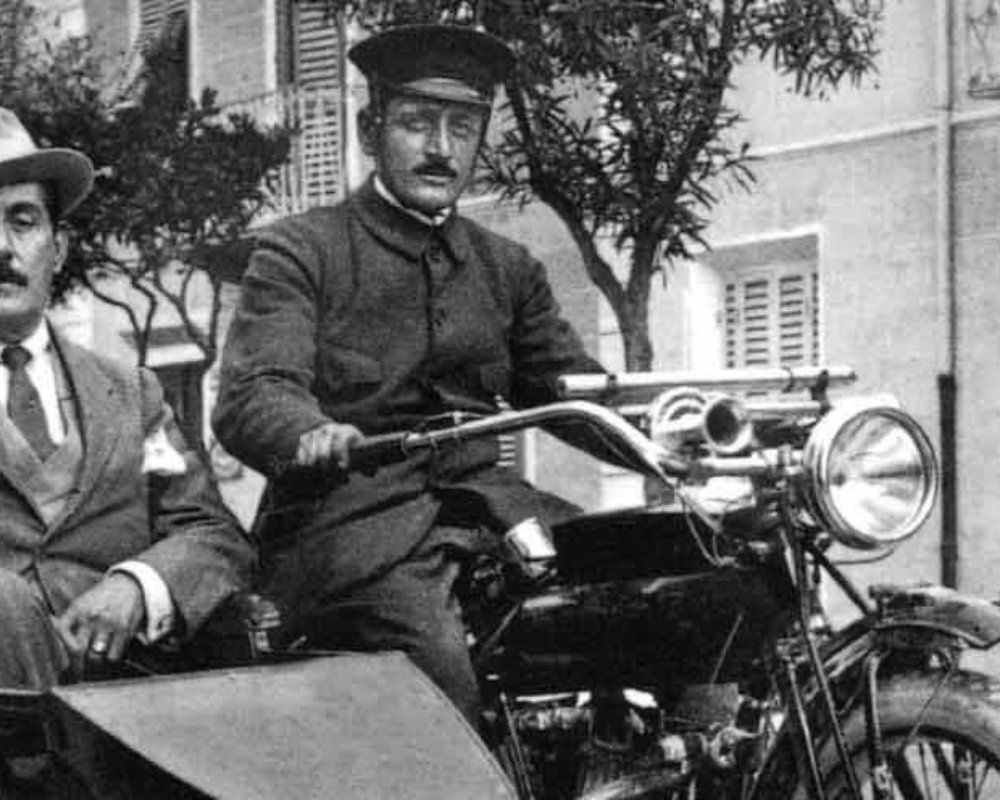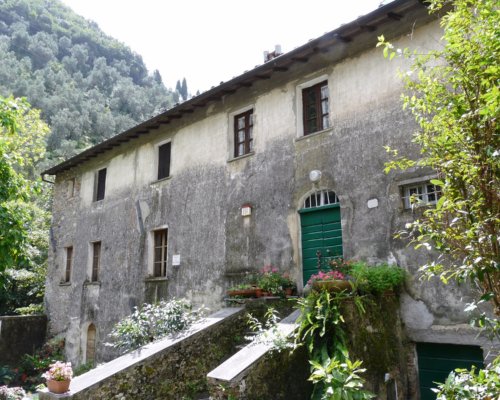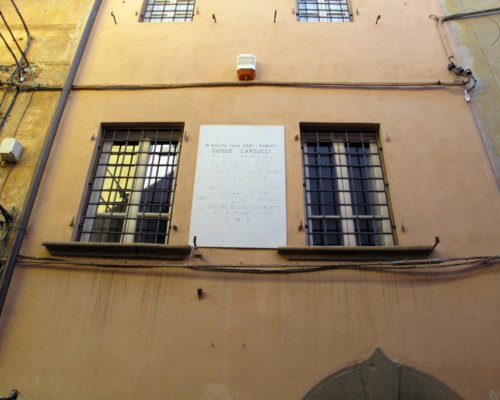A poetic and musical route between the hot springs and culture of Tuscany
It may be the climate, the dazzling colours of the hills, or the smell of the sea, Tuscany has always been the homeland to great artists. Poets, writers, painters and musicians were born or have lived part of their lives in Tuscany. Think of Leonardo da Vinci, Giotto, Dante Alighieri, Giacomo Puccini and so on.
The proposed route of the three days is to visit some of the places that have inspired these great historical figures: from Valdicastello, the birth place of Giosuè Carducci, crossing Pietrasanta and Torre del Lago, until Barga. Without forgetting the Bagni di Lucca, whose baths attracted famous writers and musicians.
Our journey starts in Versilia, a unique area surrounded by the Apuan Alps and the sea.
In the comune of Pietrasanta, in the city of Valdicastello, you can visit the house where Giosuè Carducci was born, which he left at the age of 3, but returned to years after. In 1907, just after the death of the poet, the house became a national monument and in 1912 it was acquired by the comune. Carducci remained however, connected to the place of birth, as mentioned as written in some of his works:
What I like is Piestrsanta: beautiful town,
with a single square, a cathedral of a large city,
and, in the background, the Aupan Alps. And what a country around!
What mountains, how green, what shadows, what rivers,
what fresh resonant streams under the chestnut trees and the olive trees among the green.
Of equal historic and cultural relevance, near to Pietrasanta, is the nineteenth-century villa “Versiliana”, where Gabriele D’Annunzio was a guest during the first years of the twentieth century. Since 1979 the villa has hosted cultural events. D’Annunzio loved to ride in the sunny dunes and along the shoreline, as well as appreciate the beautiful landscape.
Every year, the park of Versiliana hosts a festival of the same name. The festival is internationally renowned, dedicated to art, theatre and shows.
Nicolò Barsanti, was also born in Pietrasanta, the creator and builder of the first functioning internal combustion engine. He was the first to have the idea of transforming thermal energy into mechanical energy, and consequently into movement. A museum has been established in his honour, which displays reconstructions of motor prototypes, documents etc. The “Barsanti and Matteucci International Award” still aims to promote knowledge of invention and technological progress.
Our journey starts in Versilia, a unique area surrounded by the Apuan Alps and the sea.
In the comune of Pietrasanta, in the city of Valdicastello, you can visit the house where Giosuè Carducci was born, which he left at the age of 3, but returned to years after. In 1907, just after the death of the poet, the house became a national monument and in 1912 it was acquired by the comune. Carducci remained however, connected to the place of birth, as mentioned as written in some of his works:
What I like is Piestrsanta: beautiful town,
with a single square, a cathedral of a large city,
and, in the background, the Aupan Alps. And what a country around!
What mountains, how green, what shadows, what rivers,
what fresh resonant streams under the chestnut trees and the olive trees among the green.
Of equal historic and cultural relevance, near to Pietrasanta, is the nineteenth-century villa “Versiliana”, where Gabriele D’Annunzio was a guest during the first years of the twentieth century. Since 1979 the villa has hosted cultural events. D’Annunzio loved to ride in the sunny dunes and along the shoreline, as well as appreciate the beautiful landscape.
Every year, the park of Versiliana hosts a festival of the same name. The festival is internationally renowned, dedicated to art, theatre and shows.
Nicolò Barsanti, was also born in Pietrasanta, the creator and builder of the first functioning internal combustion engine. He was the first to have the idea of transforming thermal energy into mechanical energy, and consequently into movement. A museum has been established in his honour, which displays reconstructions of motor prototypes, documents etc. The “Barsanti and Matteucci International Award” still aims to promote knowledge of invention and technological progress.
An integral part of this journey, retracing places intrinsic to literature and music, is the house of Giacomo Puccini, in Torre del Lago. Here the famous Puccini Festival takes place every year, one of the most important international operatic events.
Torre del Lago Puccini is a town situated on the shores of Lake Massaciuccoli and was the ideal setting for Puccini. He went hunting in the marshy areas, admiring the beautiful sunsets and seeing the Apuan Alps reflected in the lake’s water.
Following the Puccinianroute, you can visit where the musician was born, in Lucca. Here, there is also the Puccini Museum in Pescaglia, found in the house that belonged to the composer’s family, where he spent most of his childhood.
The Puccini Museum in Celle di Pescaglia can be found in a beautiful 16thcentury residence. Inside there are autographed musical letters and manuscripts, original photographs, sketches of his first works: there is also the ancient kitchen which, due to the large fireplace and furnishings, will transport you back in time.
An integral part of this journey, retracing places intrinsic to literature and music, is the house of Giacomo Puccini, in Torre del Lago. Here the famous Puccini Festival takes place every year, one of the most important international operatic events.
Torre del Lago Puccini is a town situated on the shores of Lake Massaciuccoli and was the ideal setting for Puccini. He went hunting in the marshy areas, admiring the beautiful sunsets and seeing the Apuan Alps reflected in the lake’s water.
Following the Puccinianroute, you can visit where the musician was born, in Lucca. Here, there is also the Puccini Museum in Pescaglia, found in the house that belonged to the composer’s family, where he spent most of his childhood.
The Puccini Museum in Celle di Pescaglia can be found in a beautiful 16thcentury residence. Inside there are autographed musical letters and manuscripts, original photographs, sketches of his first works: there is also the ancient kitchen which, due to the large fireplace and furnishings, will transport you back in time.
We suggest finishing the route with a stop in the city of Barga. Here, in addition to the house of Giovanni Pascoli, which has become a museum, you can find the Teatro dei Differenti. Founded in 1689 and then rebuilt in 1793, the theatre has an extraordinary history, Pascoli’s speech “La grande proletaria si è mossa” was given here on 26 November 1911. It was an event that gave the theatre great cultural activity.
The Bagni di Lucca are famous for their link to the traditional spas. These spas recall figures linked to Italy and foreign cultural history, such as the musicians Gioacchino Rossini, Franz Liszt, Johann Strauss, Niccolò Paganini, Giacomo Puccini, Pietro Mascagni and writers Lord Byron, Percy Bisshe Shelley, Henry James and Eugenio Montale.
Explore Garfagnana, particularly Castelnuovo, where Ludovico Ariosto held the position of Governor for three years from 1522. In this period, he demonstrated remarkable political and practical skills. The fortress where he lived, which dominated the main square in the town, still bears the same name. Currently the building houses the municipal offices, the historical archive and the Archaeological Museum of the Territory of Garfagnana, which documents the history of the ancient population of Garfagnana from the Bronze Age to the Ligurian and Etruscan settlements.
We suggest finishing the route with a stop in the city of Barga. Here, in addition to the house of Giovanni Pascoli, which has become a museum, you can find the Teatro dei Differenti. Founded in 1689 and then rebuilt in 1793, the theatre has an extraordinary history, Pascoli’s speech “La grande proletaria si è mossa” was given here on 26 November 1911. It was an event that gave the theatre great cultural activity.
The Bagni di Lucca are famous for their link to the traditional spas. These spas recall figures linked to Italy and foreign cultural history, such as the musicians Gioacchino Rossini, Franz Liszt, Johann Strauss, Niccolò Paganini, Giacomo Puccini, Pietro Mascagni and writers Lord Byron, Percy Bisshe Shelley, Henry James and Eugenio Montale.
Explore Garfagnana, particularly Castelnuovo, where Ludovico Ariosto held the position of Governor for three years from 1522. In this period, he demonstrated remarkable political and practical skills. The fortress where he lived, which dominated the main square in the town, still bears the same name. Currently the building houses the municipal offices, the historical archive and the Archaeological Museum of the Territory of Garfagnana, which documents the history of the ancient population of Garfagnana from the Bronze Age to the Ligurian and Etruscan settlements.


